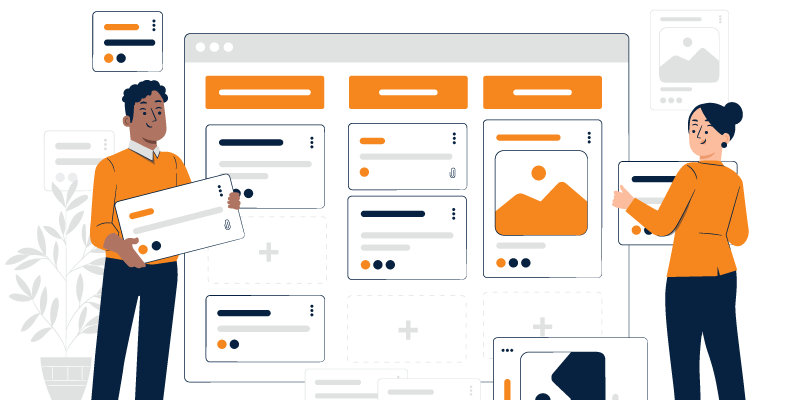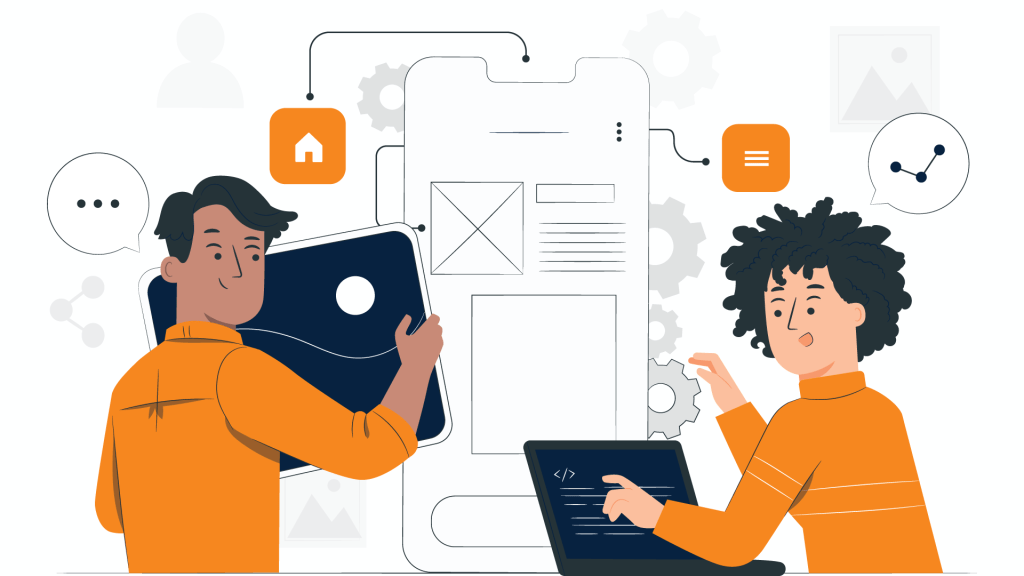In the realm of digital space, where our virtual footprints shape our daily routines, UX and UI design reigns supreme. Beyond mere aesthetics, these design disciplines possess the power to cultivate captivating and immersive digital experiences that leave users spellbound. By harmoniously merging functionality and visual allure, UX and UI designers weave a tapestry of interactivity, drawing users into a world where every click and swipe unveils new possibilities. In this intriguing voyage, we embark upon a quest to unravel the secrets behind crafting engaging digital experiences that transcend boundaries and ignite a spark of wonder within users.
What’s the Buzz About UX & UI Design?
Have you ever used an app or visited a website that felt like it was designed just for you? That’s the magic of UX and UI design working together in perfect harmony! While UX design focuses on enhancing user satisfaction by improving the usability and accessibility of a digital product, UI design is all about crafting visually appealing interfaces that captivate users at first sight.
Creating Seamless Experiences With UX Design
UX design is the secret ingredient that ensures users have a seamless and captivating experience when interacting with a digital product. Here are some key aspects of UX design that make it such a crucial part of the design process:
- User Research: A designer should understand users deeply. By conducting research and gathering insights, we can empathize with our target audience and design experiences that cater to their needs, desires, and pain points.
- Information Architecture: Think of information architecture as the blueprint of a digital product. It’s about organizing information and structuring the interface in a way that makes sense to users. When we accomplish this aspect, users can effortlessly find what they’re looking for without any frustration.
- Wireframing & Prototyping: Before going into the details, it’s essential to sketch out the outline of a design. To that end, wireframes and prototypes help us test ideas, iterate quickly, and validate our assumptions.
Unveiling the UX Process: Navigating User-Centric Design
The UX design process is a journey that uncovers user insights and transforms them into exceptional digital experiences. Let’s explore the key steps involved in this process:
1. User Interviews
Engage with users to understand their needs, goals, and pain points. These insights form the foundation of user personas and help shape the design process.
2. Research & Analysis
Dive deeper into market research, competitor analysis, and industry trends. This research provides valuable context and identifies opportunities for innovation.
3. Ideation and Prototyping
Generate ideas and translate them into tangible representations through wireframes. Rapid prototyping allows for early user feedback and iteration.
4. Iterative Design
Gather feedback through user testing, usability studies, and data analysis. Continuously improve the design based on the collected feedback, ensuring the best user experience.
By following the UX design process, designers can create solutions that truly meet user needs, resulting in engaging digital experiences. To achieve success, consider embracing this roadmap to unlock the full potential of user-centric design.
Unleashing the Power of User-Centric Experiences
Broadly speaking, user-centric design is a philosophy that places the needs, goals, and preferences of users at the center of the design process. Furthermore, it emphasizes understanding users’ behaviors, motivations, and pain points to create intuitive and meaningful experiences.
As such, user-centric design involves conducting research, gathering insights, and iterating designs based on user feedback to ensure that the final product meets their expectations and delivers exceptional usability. By adopting a user-centric approach, designers can create solutions that resonate deeply with users and ultimately lead to increased user satisfaction.
Creating Visual Elegance Through UI Design
Now that we have a solid foundation in UX design, let’s move on to the glitz and glamor of UI design. Think of UI design as the Michelangelo of the digital realm, meticulously crafting beautiful interfaces that mesmerize users. Here are some key elements to keep in mind:
Color Theory: By applying color theory principles, designers can strategically select and combine colors to evoke specific moods, create a visual hierarchy, and reinforce brand identity. Carefully chosen color palettes have the power to shape the overall look and feel of an interface.
Typography: Typography goes beyond font selection. It enhances readability, establishes hierarchy, and evokes the right tone. By thoughtfully choosing typefaces, font sizes, and spacing, designers improve legibility and guide users’ attention.
Visual Hierarchy: UI design is all about steering users’ attention and creating a clear visual hierarchy. By strategically using color, typography, and spacing, we can direct users’ focus and make the interface easy to navigate.
Consistency: Consistency is the key to a polished and professional design. By establishing a consistent visual language, we can ensure that elements across the interface behave predictably, thus creating a sense of familiarity and comfort for users.
Microinteractions: Microinteractions are those tiny animations and subtle feedback that bring a design to life. Whether it’s a button that subtly changes color on hover or a delightful loading spinner, these microinteractions make the experience feel alive and engaging.

The Yin and Yang of UX & UI Design
UX and UI design are like two peas in a pod, each contributing to the success of the other. As previously mentioned, UX design sets the stage by creating intuitive and user-centric experiences, while UI design adds the visual magic that captivates users and leaves a lasting impression. When these two disciplines work together, the result is a harmonious symphony of usability and beauty.
Armed with knowledge, we have the power to craft digital experiences that not only meet users’ needs but also ignite their imagination. So let’s put it to good use and create designs that make a difference and leave users saying, “Wow, that was incredible!”
But How? Tools and Technologies for UX & UI Design
Now that we understand the importance of UX and UI design, let’s take a look at some of the popular tools and technologies that can help bring our design visions to life:
Wireframing and Prototyping Tools
Sketch, Adobe XD, and Figma are widely popular tools used for creating wireframes and prototypes. They provide an intuitive interface and a range of features to quickly sketch out design ideas, define interactions, and gather feedback from stakeholders and users.
User Research and Testing Tools
To gather insights and validate design decisions, tools like UserTesting, Optimal Workshop, and Hotjar come in handy. They offer capabilities for conducting user research, remote user testing, heat mapping, and analyzing user behavior, enabling us to make data-driven design decisions.
Collaboration and Design Handoff Tools
When working in a team, collaboration and design handoff tools such as InVision, Zeplin, and Framer can streamline the design process. These tools allow designers to collaborate, share design assets, and provide developers with all the necessary specifications and assets they need to bring the design to life.
Visual Design Tools
Designing visually stunning interfaces requires tools like Adobe Photoshop and Adobe Illustrator. These tools offer powerful features for creating pixel-perfect designs, custom illustrations, icons, and visual assets that make our designs stand out.
Interaction Design and Animation Tools
To create captivating microinteractions and animations, tools like Adobe After Effects can be used. This tool provides a range of options that can bring designs to life with fluid animations and seamless transitions.

The Dynamic Duo: Designers and Developers Unite!
When it comes to the development process, designers and developers form a powerful partnership. Together, they make design visions a reality and ensure a seamless user experience. Here’s why UX/UI designers play a crucial role in the development process:
- Bridging Design and Development: UX and UI designers act as a bridge between design and development, translating design concepts into developer-friendly specifications. Their collaboration and iteration with developers ensure the feasibility and practicality of designs.
- Balancing Creativity and Feasibility: While designers push boundaries, developers consider technical constraints. Luckily, UX and UI designers strike a balance, collaborating with developers to find innovative solutions that meet design goals and technical requirements.
- Ensuring Consistency and Quality: Lastly, UX and UI designers establish design systems and work closely with developers to ensure consistency and quality across the interface. In the end, they mostly contribute to a polished and cohesive user experience.
At the end of the day, collaboration is key. By fostering a culture of collaboration, designers and developers can unleash the true potential of a project and create exceptional digital experiences.
Tips for Junior Designers: Excelling in UX & UI Design Collaboration
Mastering the skill of collaboration in UX and UI design is essential for junior designers who want to thrive in their roles. To that end, we have compiled a list of useful tips:
- Embrace collaboration and seek feedback from your team, especially developers;
- Communicate clearly and effectively to ensure a shared understanding;
- Learn the language of developers to effectively translate design concepts;
- Understand technical feasibility and collaborate with developers to find agreeable solutions;
- Be adaptable and flexible, go over designs based on feedback and limitations;
- Prioritize consistency and quality to create polished and cohesive designs;
- Gain knowledge and experience from seasoned designers and developers through mentorship;
- Foster a positive environment within your team;
- Continuously expand your skill set and stay updated with industry trends;
- Accept feedback and learn from mistakes to grow and improve as a designer.
Conclusion: Crafting Exceptional Digital Experiences
And finally, we’ve reached the final chapter of the captivating world of UX and UI design. We’ve learned the importance of user-centricity, the power of collaboration between designers and developers, and the role of tools and technologies in bringing designs to life. As designers, we have the opportunity to shape digital experiences that leave a lasting impact on users. By prioritizing empathy, research, and iterative design, we can create interfaces that resonate deeply with people’s needs and desires.
Remember to stay curious, embrace new trends, and never stop learning. Let your designs be a blend of creativity and usability, always keeping the user at the forefront. Nothing comes overnight, so embark on your design journey with passion, and craft exceptional digital experiences that captivate and delight users. Happy designing and may your creations leave a lasting impression!